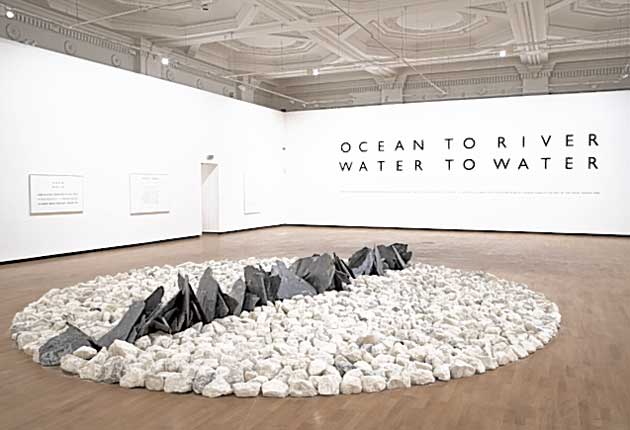Richard Long: Human Nature, Haunch of Venison, London

The world has many mysterious stone circles. Who made them? And why? We never really know. Their mystery is part of their charm. They are symbols – but of what exactly? Now we have two more. These two have cropped up – or bedded down – in a pair of 19th-century rooms in Burlington Gardens, Mayfair, and they sit on polished parquet floors beneath coffered ceilings. These stone circles, unlike the others, are not old at all. They are by Richard Long, our most celebrated land artist. Land artists make their art in reverential partnership with nature in the raw. They use wood, stones, slate, mud. They often make it in the land itself so that it gets slightly lost, as if to tell us that it is really part of its environment. This land art in Mayfair has made the journey from outdoors to indoors.
Long has been a land artist for a very long time. I spot him, a man more than half way through his seventh decade, in the lobby as I walk in. He is wiry, well weathered, and he is wearing shorts that end just below the knee. He carries a huge rucksack on his back as if he is about to embark for distant places – or perhaps he has just returned, and is already itching to leave again. Long makes his land art all over the world – well, over most of the world. Sometimes, he gathers up bits of nature, fashions it into quasi-natural, faux-prehistoric objects such as these stone circles and presents them on the floor or the walls of a gallery. At other times, he documents all his serious walking by photographing where he has been and what he has done. Just beyond the Senate Room, where we have just encountered the first of his two stone circles, we find photographs that show us how he has made his mark on the banks of the Yangtze River – by planting an entire series of jagged stones along the river's edge. He doesn't hurt nature. But he wants to show us that he has made a difference. Sometimes his artworks upon the land endure. For the most part, they are only known to have existed by the photographs that he has taken of them.
All this is very serious stuff. In the opinion of its maker. It also feels just slightly bogus, as if he is setting himself up as an ambulating mystic. The worst of him is to be found in his so-called text works. Sometimes, these are framed; at other times, they are painted directly onto a wall. The texts themselves are of the utmost banality. Quite breathtakingly so. If they aspire to the condition of poetry – and I suspect that in their heart of hearts they do – they fall woefully short. They say things like: OCEAN TO RIVER ad WATER TO WATER. Do those words resonate? The other stone circle, we are told, has been bisected by a line of jagged grey slate "on the magnetic axis". Now when we see how this circle has been cut in half by these slates, do we care that it was done "on the magnetic axis"? Does knowing this pretentious little factoid add one jot or one tittle to our enjoyment or appreciation? Is it not so much holy baloney?
To 20 August (020 7495 5050)
Subscribe to Independent Premium to bookmark this article
Want to bookmark your favourite articles and stories to read or reference later? Start your Independent Premium subscription today.

Join our commenting forum
Join thought-provoking conversations, follow other Independent readers and see their replies